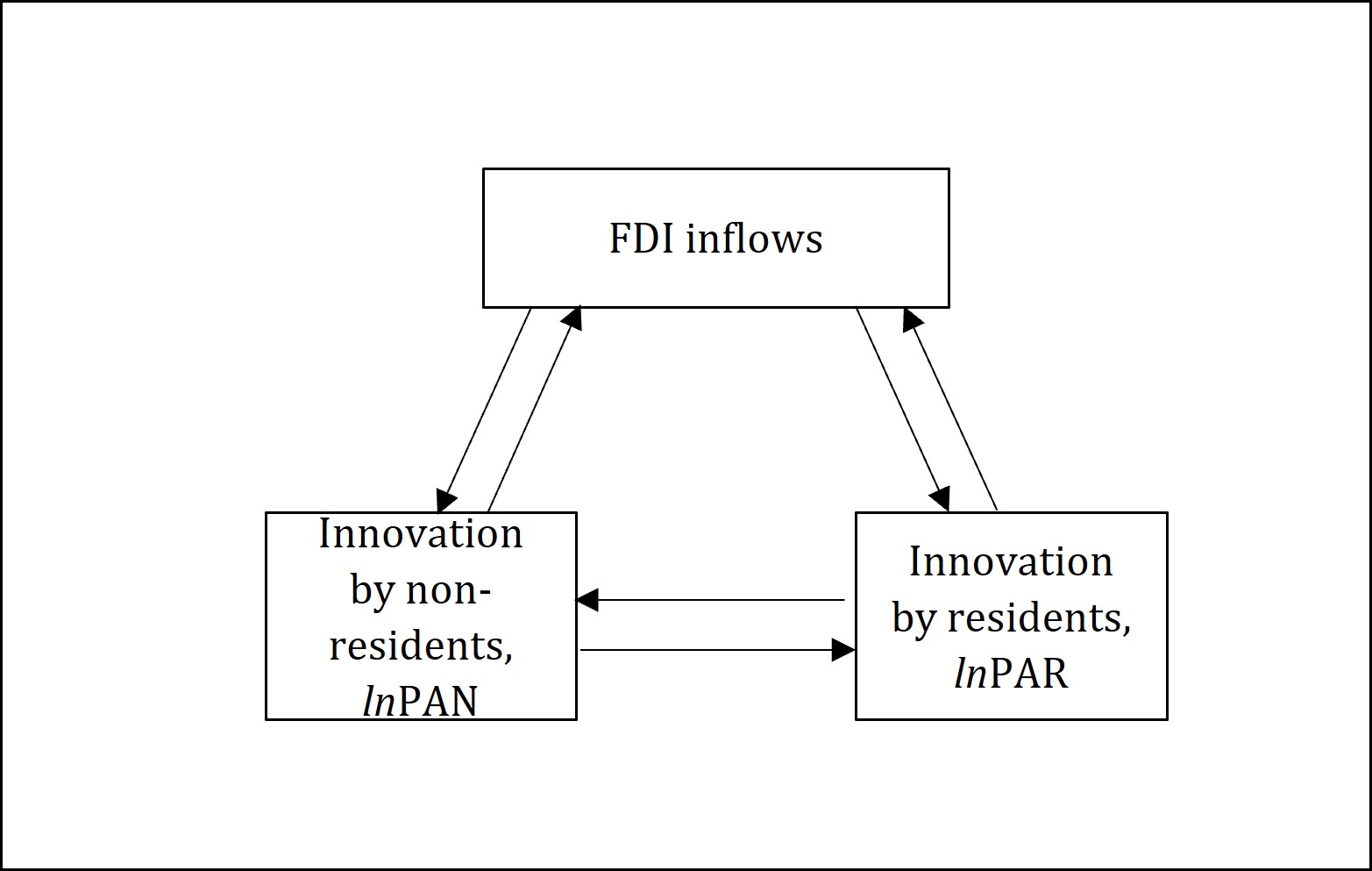Inward foreign direct investment and innovation: Which comes first?
Main Article Content
Abstract
This study re-examines the direction of causality between inward foreign direct investment (FDI) and innovation (residents and non-residents) by considering balanced panel data of 56 countries (2000-2020). The vector auto-regressive (VAR) Granger non-causality tests show a direction from FDI inflows to innovation (non-residents), where FDI comes first (FDI-led innovation), while there is bidirectional causality between innovation by non-residents and residents, in general. For developed economies, FDI causes innovation by non-residents, but is caused by residents' innovation. There is no causation between FDI and innovation in either developing economies or economies in transition. These findings were further complemented by impulse response functions and various decomposition tests. Some policy relevance is highlighted.
Article Details

This work is licensed under a Creative Commons Attribution-NonCommercial-NoDerivatives 4.0 International License.
References
Bertschek, I. (1995). Product and process innovation as a response to increasing imports and foreign direct investment. The Journal of Industrial Economics, 43(4), 341–357. doi: 10.2307/2950548
Blind, K., & Jungmittag, A. (2004). Foreign direct investment, imports and innovations in service industry. Review of Industrial Organisation, 25(2), 205–227. doi: 10.1007/s11151-004-3537-x
Brambilla, I., Hale, G., & Long, C. (2009). Foreign direct investment and the incentives to innovate and imitate. The Scandinavian Journal of Economics, 111(4), 835–861.
Breitung, J. (2001). The local power of some unit root tests for panel data. In Baltagi, B.H., Fomby, T.B. & Carter, H. (Ed.), Nonstationary Panels, Panel Cointegration, and Dynamic Panels - Advances in Econometrics, 15, 161–177. doi:10.1016/S0731-9053(00)15006-6
Buckley, P., Clegg, J., & Wang, C. (2002). The impact of Inward FDI on the performance of Chinese manufacturing firms. Journal of International Business Studies, 33(4), 637–655. doi: 10.1057/palgrave.jibs.8491037
Chen, Y., Jiang, H., Liang, Y., & Pan, S. (2022). The impact of foreign direct investment on innovation: evidence from patent filings and citations in China. Journal of Comparative Economics, 50(4), 917–945. doi: 10.1016/j.jce.2022.05.005
Cheung, K.Y., & Lin, P. (2004). Spillover effects of FDI on iInnovation in China: Evidence from the provincial data. China Economic Review, 15(1), 25–44. doi: 10.1016/S1043-951X(03)00027-0
Dumitrescu E, Hurlin C (2012). Testing for Granger non-causality in heterogeneous panels. Economic Modelling, 29(4), 1450 –1460. doi: 10.1016/j.econmod.2012.02.014
Erdal, L., & Gocer, I. (2015). The effects of foreign direct investment on R&D and innovations: panel data analysis for developing asian countries. Procedia - Social and Behavioral Sciences, 195, 749–758. doi: 10.1016/j.sbspro.2015.06.469
Garcia, F., Jin, B., & Salomon, R. (2013). Does inward foreign direct investment improve the innovative performance of local firms? Research Policy, 42(1), 231–244. doi: 10.1016/j.respol.2012.06.005
Ghimire, S., & Paudel, N. (2019). R&D, FDI, and Innovation: examination of the patent applications in the OECD countries. Journal of Development Innovations, 3(2), 1–11.
Granger, C.W.J. (2003). Some aspects of causal relationships. Journal of Econometrics, 112(1), 69–71. https://doi.org/10.1016/S0304-4076(02)00148-3
Granger, C.W.J. (1988) Some recent development in a concept of causality. Journal of Econometrics, 39(1–2), 199–211.http://dx.doi.org/10.1016/0304-4076(88)90045-0
Granger, C. W. J. (1969). Investigating causal relations by econometric models and cross-spectral methods. Econometrica, 37(3), 424–438. doi:10.2307/1912791
Hintosova, A. B. (2021). Inward FDI: characterizations and evaluation. Encyclopedia, 1(4), 1026–1037. doi:10.3390/encyclopedia1040078
Hymer S.H. (1960). The International Corporations of National Firms: A Study of Direct Foreign Investment. (Doctoral thesis). Massachusetts Institute of Technology. Retrieved from http://hdl.handle.net/1721.1/27375
Im, K. S., Pesaran, M. H., & Shin, Y. (2003). Testing for unit roots in heterogeneous panels. Journal of Econometrics, 115(1), 53–74. doi:10.1016/S0304-4076(03)00092-7
Jores, R., & Law, S. (2016). ARDL bound test approach for co-integration between FDI, human capital and innovation activities: insights from Malaysia. Journal of Advanced Research in Business and Management Studies, 5(1), 57–71.
Khachoo, Q., & Sharma, R. (2016). FDI and Innovation: an investigation into intra- and inter-industry effects. Global Economic Review, 45(4), 311–330. doi:10.1080/1226508X.2016.1218294
Levin, A., Lin, C.F., & Chu, C.S. (2002). Unit root tests in panel data: asymptotic and finite-sample properties. Journal of Econometrics, 108(1), 1–24. Retrieved from https://EconPapers.repec.org/RePEc:eee:econom:v:108:y:2002:i:1:p:1–24
Lin, H. l., & Lin, E. S. (2010). FDI, trade, and product innovation: theory and evidence. Southern Economic Journal, 77(2), 434–464.
Liu, X., & Zou, H. (2008). The impact of greenfield FDI and mergers and acquisitions on innovation in Chinese high-tech industries. Journal of World Business, 43(3), 352–364. doi: 10.1016/j.jwb.2007.11.004
Maddala, G. S., & Wu, S. (1999). A comparative study of unit root tests with panel data and a new simple test. Oxford Bulletin of Economics and Statistics, 61(S1), 631–652. doi: 10.1111/1468-0084.0610s1631
Nyeadi, J. D., & Adjasi, C. (2020). Foreign direct investment and firm innovation in selected sub-Saharan African countries. Cogent Business & Management, 7(1), 1–23. doi:10.1080/23311975.2020.1763650
OECD. (2015). Policy Framework for Investment, Paris: OECD Publishing. Retrieved from https://www.oecd.org/investment/pfi.htm
OECD. (2022). FDI Qualities Policy Toolkit. Paris: OECD Publishing. Retrieved from https://www.oecd.org/daf/inv/investment-policy/FDI-Qualities-Policy-Toolkit-Consultation-Paper-2021.pdf
Palit, A., & Nawani, S. (2007). Technological capability as a determinant of FDI inflows: evidence from developing Asia & India. (Indian Council for Research on International Economic Relations Working Paper No. 193). Retrieved from https://ideas.repec.org/p/ind/icrier/193.html
Pham, N. T., & Pham, H. T. T. (2020). The Role of patent on foreign direct investment: evidence in Vietnam. Journal of Distribution Science, 18(6), 77–82. doi:10.15722/JDS.18.6.202006.77
Singh, J. (2007). Asymmetry of knowledge spillovers between MNCs and host country firms. Journal of International Business Studies, 38(5), 764–786.
Stiebale, J., & Reize, F. (2011). The Impact of FDI through mergers and acquisitions on innovation in target firms. International Journal of Industrial Organization, 29(2), 155–167. doi: 10.1016/j.ijindorg.2010.06.003
Tang, T. C. & Lai, S. L. (2022). Government spending on tertiary education, knowledge, technology, and economic growth. Journal of Economic Development, 47(4), 99–122
United Nations. 2022. The sustainable development goals report 2022. New York, USA: UN DESA
Yue, W. (2022). Foreign direct investment and the innovation performance of local enterprises. Humanities and Social Sciences Communications, 9, 252(1-9). doi:10.1057/s41599-022-01274-6

